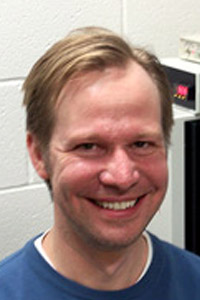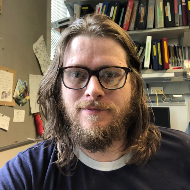 Christopher Stipp, associate professor of biology at the University of Iowa, is involved in medical research, including research conducted by utilizing ecological and evolutionary principles. He provides an expert opinion on how evolution is clearly ingrained in the treatments medical professionals provide their patients. I interviewed Stipp recently to explore the concept of evolutionary medicine, how diseases are influenced by evolutionary factors, and the ways evolution can be leveraged to develop treatment strategies. Evolutionary medicine may be an underutilized topic for science outreach: disease progression can be tied directly to evolution and can be seen in real-time, and most people have firsthand experience with disease. Leveraging those experiences while helping to make connections to evolution could perhaps reduce the barriers to evolution acceptance.
Christopher Stipp, associate professor of biology at the University of Iowa, is involved in medical research, including research conducted by utilizing ecological and evolutionary principles. He provides an expert opinion on how evolution is clearly ingrained in the treatments medical professionals provide their patients. I interviewed Stipp recently to explore the concept of evolutionary medicine, how diseases are influenced by evolutionary factors, and the ways evolution can be leveraged to develop treatment strategies. Evolutionary medicine may be an underutilized topic for science outreach: disease progression can be tied directly to evolution and can be seen in real-time, and most people have firsthand experience with disease. Leveraging those experiences while helping to make connections to evolution could perhaps reduce the barriers to evolution acceptance.
Joe Jalinksy: To what extent are evolutionary principles being used in medical research and what do you think the strengths are for evolution-informed treatment strategies?
Christopher Stipp: As a cancer researcher, you can see evolution happening in patients and in cell cultures because you have a large population that is genetically diverse, and you are putting it under selection, especially with targeted therapies. Therapy resistance is evolution happening in real-time. These cells have unstable plastic genomes so you're getting lots of genetic variation in the population and some tumors have defined oncogenic lesions that are the driver mutations and there are therapies that specifically target those drivers and have dramatic clinical success. But it's almost always temporary; we see resistance emerging. It is just a matter of fact that evolution is happening. Some of the ways that evolution could inform treatment include thinking about the kind of selective pressure that treatments are applying and does that make you want to alter the timing. One phenomenon we are investigating in my lab right now is that in drug-resistant melanoma cells we found instances where the drug-resistant cells are at a proliferative advantage but only in the presence of the drug. In the absence of the drug the non-resistant cells are more fit. That raises possibilities of things like drug holidays or phased treatments instead of constantly applying the same selective pressure.
JJ: This reminds me of an analogy that is often used in cancer treatment. If you imagine a tumor as a tree, it may be to the benefit of the patient to trim the branches instead of cutting the whole tree down. Attempting to completely eradicate a tumor is not guaranteed and what you end up with is a situation where you have very strong selection on the tumor.
CS: There are examples in prostate cancer, which is often a slow-growing cancer, where it makes sense to keep an eye on it and not mess with it too much. An example is with immunotherapy. This is a relatively newer form of treatment where what we're doing is helping to activate the immune system to go after the cancer. Tumor cells look like foreign cells to some extent and there is immune surveillance where the immune system can recognize the tumor. Tumor cells then can employ checkpoints that are part of the normal system that keeps immunity from running amok and turning into autoimmunity, and that causes the immune system to back off and leave the tumor alone. There are ways to interfere with those checkpoints and take them back off and reignite the immune response and this can result in something called stable disease. You can get regression and you often see regressions but not 100% eradication. Then you get stable disease which is where the tumor cells are not getting bigger.
JJ: Do you find that understanding a population of cancer cells in more of a population-genetic framework, the way a biologist might think about them, is pervasive in the medical field?
CS: The patients have a life-threatening disease and you have to offer something now—whether you understand what is best or not you have got to do something. One of the guys I work with describes it like you're standing with somebody at the edge of a cliff and there's a rhinoceros charging, and you don't have anything to protect yourself. If you don't have a spear you look around and find a rock and you throw that rock. The research that we're doing now is not instantly translatable but some of the stuff that's working now grew out of basic research and I would expect that to be true for understanding tumor heterogeneity. Some of those melanoma cell lines and patient specimens that I work with—you put them under drug selection and you can get clones of drug resistant cells. When you analyze those clones it turns out they've taken different paths. Some have become resistant by one mechanism and some have become resistant via another. What does this mean for the patient? Let's say you want to try to understand how the cells are going to be resistant. So you do combination therapy up-front to try to treat the original cells and the resistance cells that you expect to emerge.But if there are five ways to become resistant that changes things a lot. How often is that true? Is that the rule or is that unusual?
JJ: How would you lay out a case to the general public that evolutionary thinking in cancer research provides a useful direction?
CS: You can just explain to them that one of the big problems in cancer is that even within one patient it may be multiple versions of the disease going on at once and so we've got these tumor cells that have genetic differences. And that creates a major treatment challenge because you're trying to treat maybe two, three, or more different tumor cells coexisting in the same patient. It's really important for us to understand how these tumor cells evolved under drug treatment. I think you can just say ‘evolve under drug treatment’ because that is intuitive. You are not really invoking some kind of evolution as a worldview but you're putting it in there as something that happens. People will understand that treatments that work for a while stopped working and the reason is because the tumor cells are evolving under the treatment.
JJ: And that’s why I think evolutionary medicine could be a powerful tool for science outreach. These treatments work because evolution is true. And sometimes they don’t work because of evolution.
CS: Right, And it happens in real time over the space of months to years in patients. They don’t have to imagine this unfolded over millions of years. Understanding the dynamics of how tumor cells evolve under treatment may give us insights into which treatments will work best in which order. If we understood more about how the tumor cells become resistant, how the drug is selecting for resistance, and the strategies that tumor cells use to become resistant, that's bound to inform treatment strategies and to help optimize them to create the longest possible remissions. You do drug A and then when it stops working. switch to drug B. But then the cells that become resistant to drug B may actually be sensitive again to A. Different cycles of treatment that you won't know until you understand how one strategy works in a context-dependent way.
See also "Why are humans imperfect and what does evolution have to do with it?"

